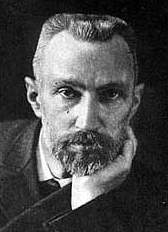Pierre Curie
|
|
Pierre Curie (May 15, 1859 – April 19, 1906) was a pioneer in the study of crystallography, magnetism, piezoelectricity and radioactivity.
Pierre was educated at home by his father, and in his early teens showed a strong aptitude for mathematics and geometry. By the age of 18 he had completed the equivalent of a higher degree, but did not proceed immediately to a doctorate due to lack of money. Instead he worked as a laboratory instructor.
In 1880, Pierre and his older brother Jacques demonstrated that an electric potential was generated when crystals were compressed. Shortly afterwards, in 1881, they demonstrated the reverse effect: that crystals could be made to deform when subject to an electric field. Almost all digital electronic circuits now rely on this phenomenon in the form of crystal oscillators.
Prior to his famous doctoral studies on magnetism he designed and perfected an extremely sensitive torsion balance for measuring magnetic coefficients. Variations on this equipment were commonly used by future workers in that area. Pierre Curie studied ferromagnetism, paramagnetism, and diamagnetism for his doctoral thesis, and discovered the effect of temperature on paramagnetism which is now known as Curie's law. The material constant in Curie's law is known as the Curie constant. He also discovered that ferromagnetic substances exhibited a critical temperature transition, above which the substances lost their ferromagnetic behaviour. This is now known as the Curie point.
Pierre worked with his wife Marie Curie in isolating polonium and radium. They were the first to use the term 'radioactivity', and were pioneers in its study. Their work, including Marie's celebrated doctoral work, made use of a sensitive piezoelectric electrometer constructed by Pierre and his brother Jacques.
Pierre and one of his students made the first discovery of nuclear energy, by identifying the continuous emission of heat from radium particles. He also investigated the radiation emissions of radioactive substances, and through the use of magnetic fields was able to show that some of the emissions were positively charged, some were negative and some were neutral. These correspond to alpha, beta and gamma radiation.
Together with his wife, Marie, Pierre was awarded the Nobel Prize in physics in 1903: "in recognition of the extraordinary services they have rendered by their joint researches on the radiation phenomena discovered by Professor Henri Becquerel."
The curie is a unit of radioactivity (3.7 x 1010 decays per second or 37 gigabecquerels) originally named in honour of Pierre Curie by the Radiology Congress in 1910, after Pierre's death.
Pierre died as a result of a carriage accident in a rain storm while crossing the rue Dauphine in Paris on April 19, 1906. His head having been crushed under the carriage wheel, he avoided probable death by the radiation poisoning that later killed his wife. Both Pierre and Marie were enshrined in the crypt of the Pantheon in Paris in April 1995.
Pierre and Marie Curie's daughter Irène Joliot-Curie and their son-in-law Frédéric Joliot-Curie were also physicists involved in the study of radioactivity.
External links
- Pierre Curie's Nobel prize (http://www.nobel.se/physics/laureates/1903/index.html)
- official Nobel biography (http://www.nobel.se/physics/laureates/1903/pierre-curie-bio.html)
- Nobel article about Marie Curie (http://www.nobel.se/physics/articles/curie/index.html)
- Nobel article about Pierre Curie (http://www.nobel-winners.com/Physics/pierre_curie.html)de:Pierre Curie
es:Pierre Curie eo:Pierre CURIE fr:Pierre Curie gd:Pierre Curie gl:Pierre Curie ko:피에르 퀴리 is:Pierre Curie nl:Pierre Curie ja:ピエール・キュリー no:Pierre Curie pl:Piotr Curie pt:Pierre Curie ro:Pierre Curie fi:Pierre Curie sv:Pierre Curie

